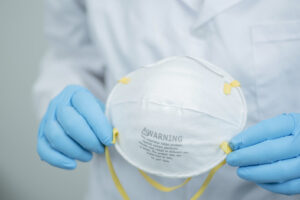The transfusion medicine community staff are at risk of SARS-CoV-2 transmission; both laboratory technologists in the hospital and staff at blood donor collection centers are forced to work closely with others. A systematic review and meta-analysis recently published in The Lancet indicates that physical distancing, face masks, and eye protection all help to reduce person-to-person transmission of betacoronaviruses. The study evaluated transmission of severe acute respiratory syndrome (SARS), Middle East respiratory syndrome (MERS), and severe acute respiratory syndrome coronavirus 2 (SARS-CoV2) in 172 observational studies and 44 comparative studies (n=25,697 patients) in both health-care and non-health-care settings. Physical distancing of at least 1 meter provides a strong protective effect compared to distances less than 1 meter (n=10,736; pooled adjusted odds ratio [aOR], 0.18 [95% CI, 0.09 to 0.38]), but 2 meters reduced transmission further. Face masks of all kinds provide protection (n=2647; aOR, 0.15 [95% CI, 0.07 to 0.34]) with the strongest protection provided by N95 or similar masks. Eye-protection was also associated with less transmission (n=3713; aOR, 0.22 [95% CI, 0.12 to 0.39]) and may be acceptable personal protective equipment for everyone, including the general population. Physical distancing and use of PPE are effective strategies that should be employed throughout the transfusion medicine community and beyond.
Reference:

